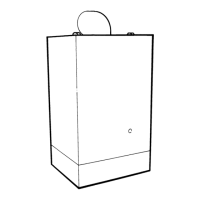Supplied By www.heating spares.co Tel. 0161 620 6677
23
221504A
TABLE 6
APPROX.GAS RATE min med max
ECONOMY
m
3
/h
1.8 1.9 2.1
PLUS 60F
ft
3
/h
63.0 68.5 74.0
Diagram 10.5
PRESSURE TEST POINT
10 Commissioning
PRESSURE TEST
POINT SCREW
10.4 Testing - Gas
With the boiler on proceed as follows:
Test for gas soundness around the boiler gas components
using a suitable leak detection fluid, in accordance with the
current issue of BS6891.
Check the main burner gas pressure at least 10 minutes after
the boiler has lit, refer to Data label.
If necessary adjust the main burner flow rate regulator screw to
obtain the required gas pressure setting, turn clockwise, to
decrease the pressure as shown in diagram 10.4.
Should any doubt exist about the gas rate, check it using the gas
meter test dial and a stop watch, at least 10 minutes after the
burner has lit, making sure that all other gas burning appliances
and pilot lights are off.
The gas rates shown in Table 6 are for guidance only, dependent
on the heat setting.
Turn the boiler thermostat knob fully anti-clockwise to “O”.
Remove the pressure gauge from the test point and refit the
screw, ensuring that a gas tight seal is made.
When the boiler thermostat is turned to the “O” position, by
hand, wait at least 30 seconds before turning “On” again.
There may be an initial smell given off from the boiler when new,
this is quite normal and it will disappear after a short period of
time.
Refit the gas valve terminal cover.
Refit the electrical controls box.
Note: Make sure that the air pressure switch tubes do not kink.
10.5 Heating System
Check that all remote controls are calling for heat.
Turn the boiler thermostat knob fully clockwise to the maximum
setting.
Allow the system to reach maximum temperature and examine
for water leaks. The boiler should then be turned off and the
system drained off as rapidly as possible whilst still hot.
Refill the system, vent and again check for water soundness.
For sealed systems adjust to initial design pressure. The set
pointer on the pressure gauge should be set to coincide with the
indicating pointer.
The overrun thermostat will keep the pump running when the
boiler shuts down, so long as the temperature within the boiler
is above a predetermined level.
When commissioning the system the boiler should be fired on
full service, that is, central heating and domestic hot water. The
system should then be balanced, adjusting the pump and
lockshield valve as necessary. Having achieved a satisfactory
condition operate the boiler with the bypass fully closed on
minimum load, normally this will be central heating with one
radiator, in the main living area working. The valve should be
gradually opened to achieve the minimum flow rates given in
Section 2. This can be checked by measuring the water
temperature difference between the boiler flow and return
connections. The difference MUST NOT exceed 16
o
C.
If necessary readjust the pump.
Under NO circumstances should this valve be left in the FULLY
CLOSED position.
3315
10.6 Operational Checks
Adjust the boiler thermostat and any system controls to their
required settings.
Do not attempt to adjust the thermostat calibration screw.
Operate the boiler again on full service and check that the
balancing is satisfactory, making further adjustments as
necessary to the system, radiator valves and bypass.
On open vented systems there must be no pumping over of
water or entry of air at the vent above the feed and expansion
cistern.
If thermostatic radiator valves are fitted care must be taken to
ensure that there is an adequate flow rate through the boiler and
bypass when the valves are closed, refer to the current issue of
BS7478 for guidance.
Refit the outer case using the screws from the fittings pack, see
diagram 10.7.

